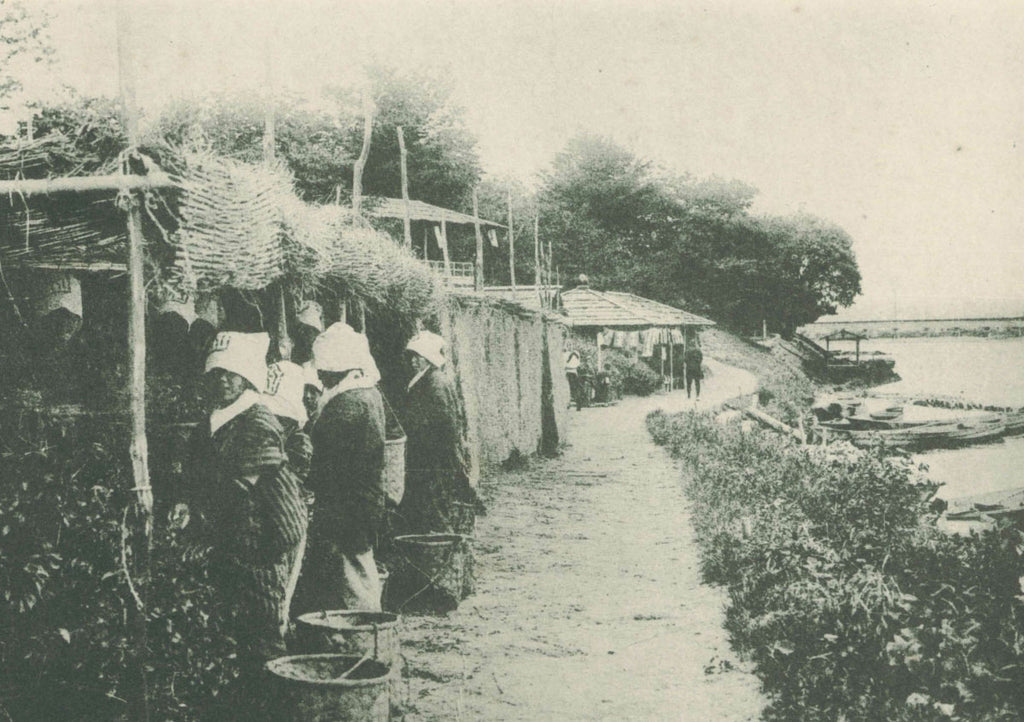Uji’s climate and terrain that are perfect for tea cultivation
It is said that tea cultivation in Uji was started by Myoe, a monk who rebuilt Kozan-ji Temple in Toganoo. At the beginning of the Kamakura period, Zen master Eisai taught people how to make matcha tea that he had learned from his time in the Song Dynasty and brought along with him the tea seeds, and Myoe found a place to grow them in Uji.
Uji is a relatively rainy region with warm temperatures. But unlike nearby Kyoto, it rarely snows. Uji’s climate is perfect for growing the subtropical tea plant.
The Ujigawa River, depicted in “The Ten Quires of Uji” of “The Tale of Genji”, as a river shrouded in fog, contributes to this warm climate.
Ujigawa River flows out of Lake Biwa, makes a 90-degree turn near Fushimi as if encircling the plains of Uji, before it empties into Osaka Bay as Yodogawa River. The current blocks the northerly winds blowing from Kyoto and protects Uji from the cold. The fog generated by the river also serves as a natural veil that protects Uji from frost, the great enemy of tea.
In addition, Uji is an alluvial fan (fan-shaped area) that was formed in ancient times when a large amount of sediments was washed away by the water currents in the Yamashiro. The well-drained, well-ventilated, and fertile land was ideal for growing tea plants that would survive over many centuries.
The land created by the mountains and rivers became the best environment for tea cultivation. This is the number one reason why tea cultivation has flourished in Uji.

Collection of Uji City Historical Museum
Matcha, sencha, gyokuro invented in Uji
Another reason for Uji tea’s development was Uji’s proximity to Kyoto.
Kyoto, where emperors, generals, and court nobles lived, was a major consumer of tea. Under the patronage of those in power then, the exclusive use of Uji tea in the tea ceremony was a major factor that drove Uji’s tea production. The continual efforts to make better products eventually led to three innovations that transformed the history of Japanese tea: matcha, sencha, and gyokuro.
The first innovation is matcha, a Japanese specialty, that is produced through “shade-grown cultivation”.
Shade-grown cultivation is the cultivation of tea plants in shade (out of direct sunlight) under a covering in early spring when the shoots are emerging. The tea leaves that shoot under the covering allow a rich level of umami to accumulate in the leaves, which then turn translucent green in color. Although the covering was originally used to prevent frost damage, it has led to the production of the brilliant green matcha unique to Japan. While shade-grown cultivation was said to have started in the 16th century, research carried out on the Okunoyama Tea Garden indicated that it may have already been practiced since the first half of the 15th century.
The second innovation is sencha, which was invented in the mid-Edo period by Soen Nagatani, a tea farmer and producer in Ujitawara. In Genbun 3 (1738), he invented a new production method inspired by kamairi-cha (pan-fried tea leaves), a roasted tea brought from the Ming Dynasty in China. The tea leaves were steamed, then rolled and dried over a tea-rolling table. Unlike brown tea, which was boiled and drunk, this process produces a light green tea called “Uji sencha” that is fragrant and sweet, which later spread from Edo throughout Japan.
The third innovation is “gyokuro”, which was created about a century after sencha was invented. Gyokuro is produced through a combination of shade-grown cultivation and Uji sencha production. This fusion of Uji’s original cultivation and tea production methods has led to the creation of the finest green tea.
Our predecessors made the best use of the blessings of the earth and its geographical advantages, and worked hard to create more beautiful and flavorful teas. 800 years have since passed and it is without a doubt that the nature and people of Uji have cultivated Uji tea.

Collection of Uji City Historical Museum


